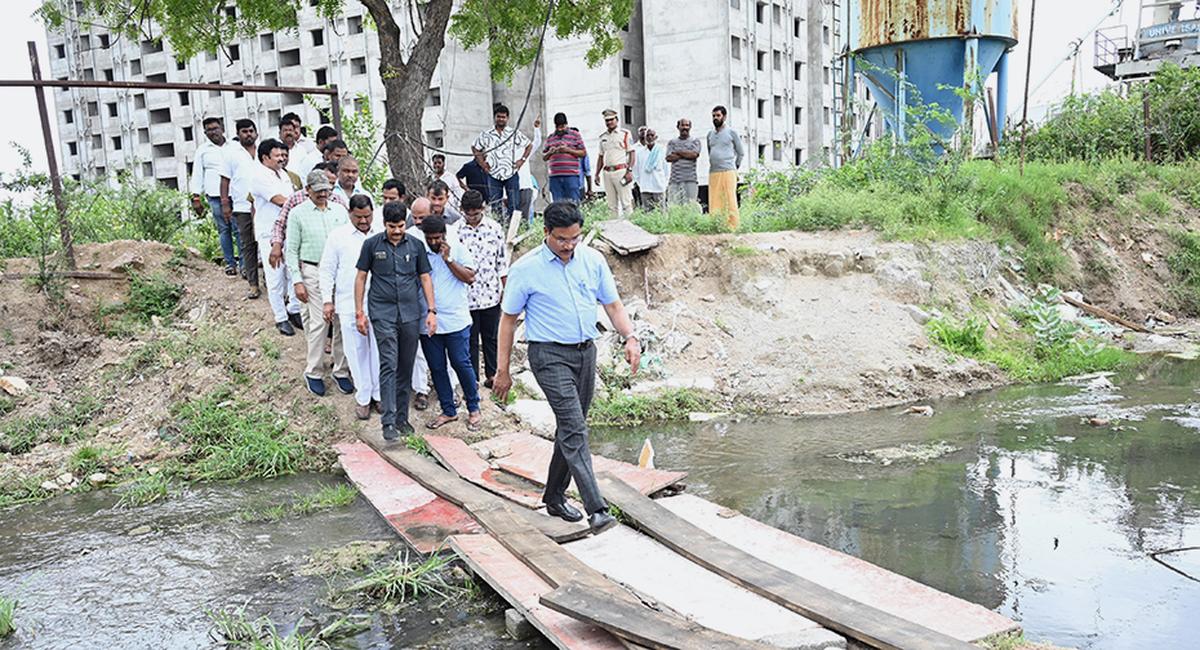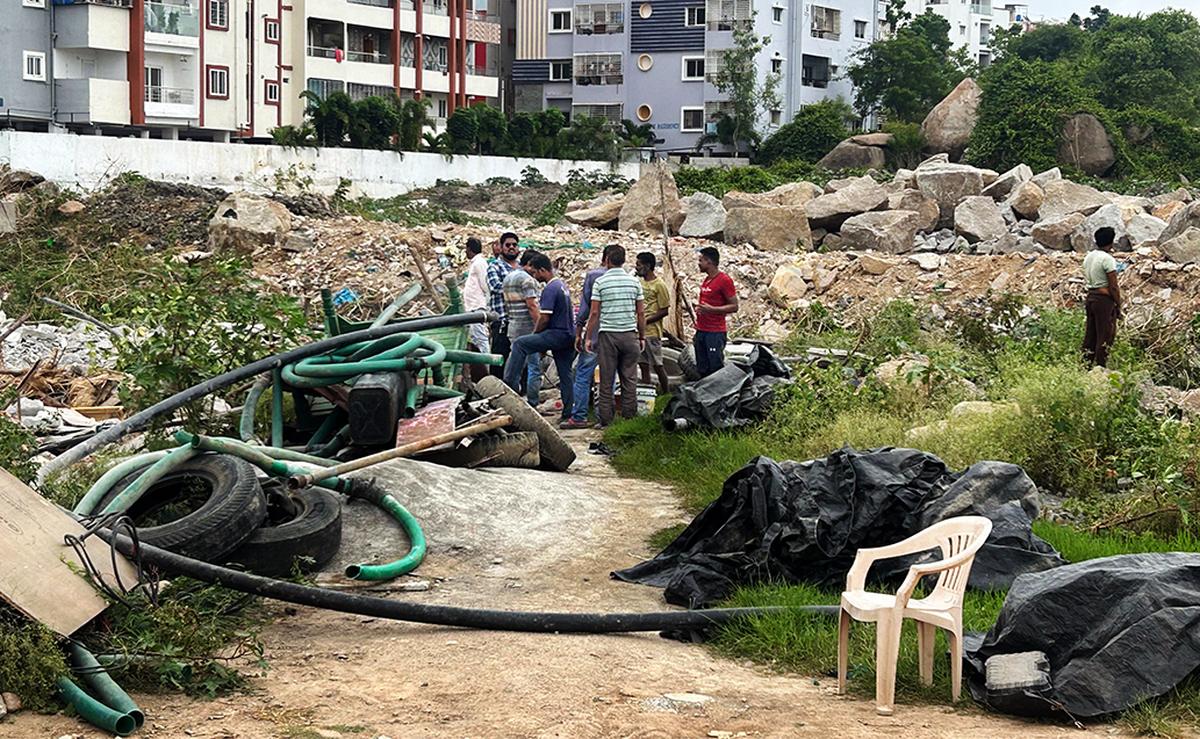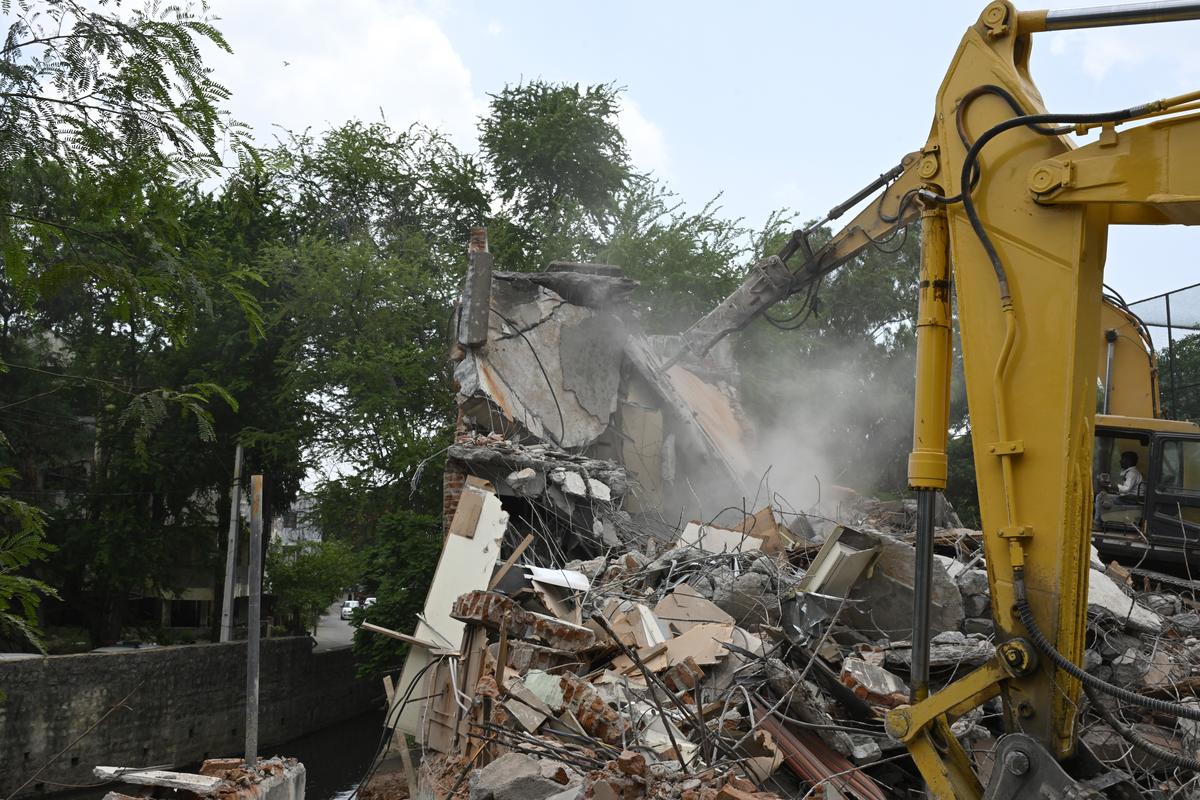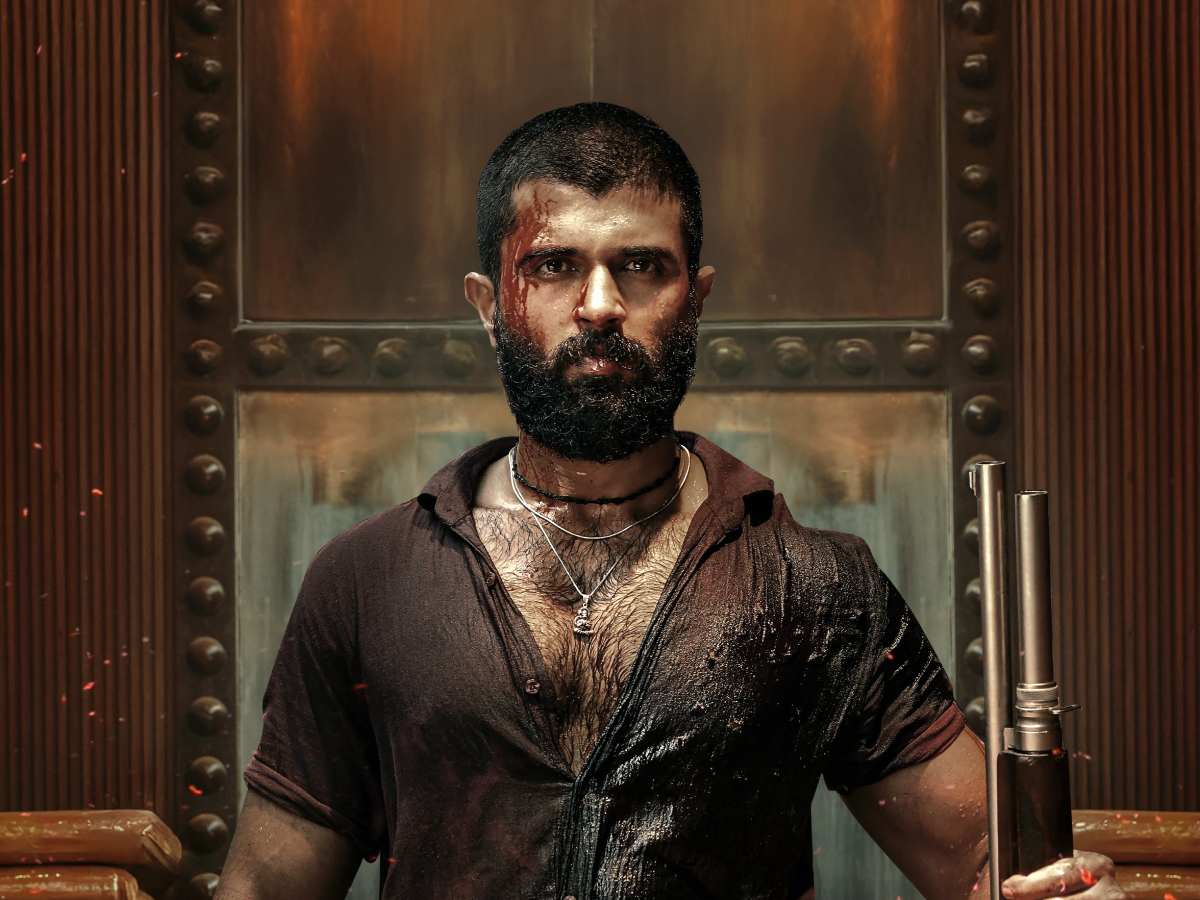The Hyderabad Disaster Response & Asset Protection Agency (HYDRAA) has created ripples in the city’s civic enforcement scene in its first year of existence. Its functioning, however, has not been without controversy. In this interview, HYDRAA Commissioner A.V. Ranganath reflects on the agency’s year-long journey. Edited excerpts:
Q. Can you dwell upon the achievements of HYDRAA over the past one year? Have you been able to live up to the objective with which HYDRAA was established?
A. HYDRAA was created by an executive order last year, on July 19, 2024, with the twin objectives of Disaster Management/Response coupled with Asset Protection. One of the major achievements is creation of awareness among the public against encroachment of lakes and water bodies. Recently we conducted an exhibition at Ravindra Bharathi. It was a school exhibition. Many schools, both government and private, participated. Children aged around 8-9 years age knew what FTL (full tank level) is and what buffer is — something that I got to know only after taking over as HYDRAA Commissioner. The public is aware of legal issues. Their awareness has helped us a lot in checking or reducing the pace with which encroachments are taking place in Hyderabad city. Last year, when I joined HYDRAA as Commissioner, I visited the National Remote Sensing Centre. I met the director Prakash Chauhan and some scientists there. Through a presentation, they showed us that 61% of lakes in Hyderabad are already encroached and the pace at which the encroachments are happening, in another 12-15 years, all the lakes in the city would disappear, if left unchecked.
For us, the first thing was to check rampant encroachment in a stern way. With that in mind, we went tough on the encroachments in the initial months. The intent is to reduce the rate at which the encroachments are happening. You can see that the water body encroachments have come to a standstill. I am not saying it has completely stopped, but it has rapidly reduced.
The second step was to see that encroached land is reclaimed. HYDRAA is developing six lakes with government funds. We have taken over the land and now we are rejuvenating the lakes. Bathukamma Kunta, for instance, was no lake. It was a garbage dumping yard. Nobody had even imagined a lake to be there. Now, it has been revived and there is a huge water body there. We had a meeting on July 18 at Bathukamma Kunta, and the people from nearby slums and localities came forward and participated in the celebrations.
Q. What was the reason for choosing the first three operations — Lotus Pond, Bam Rukn-ud-Daula Lake and Thammidi Kunta? Did you want to instil fear?
A. No. The Lotus Pond was a park encroachment. One Narne Gokul from Narne Estate had encroached the neighbouring park land of almost an acre, worth ₹100 crore in that particular area. That was the day I joined as Commissioner of EVDM [Enforcement, Vigilance, Disaster Management, a precursor to HYDRAA]. Following media reports about the encroachment there, our immediate reaction was to go there. Whatever wall had been constructed was immediately removed. We erected our own fencing.
About the other two, I had asked the other departments about the cases that were pending execution. In those [Bam Rukn-ud-Daula and N-Convention] issues, the speaking orders by the municipal authorities concerned were complete, and the process was done. Only execution was pending. I don’t know what had stopped them from going ahead with the execution, but we thought we would pick up such cases and start executing. Being high-profile cases, they got media attention, but we did it in very routine [manner]. At that time, we were not delegated powers under various enactments.

Q. Were there any pressures on you — like in case of Bam-Rukn-ud-Daula, when some political leaders arrived at the site?
A. The local MLA, who apparently was identified as encroacher there [Bam-Rukn-ud-Daula], was immediately picked up and taken to the police station. We demolished the building he was constructing, and a lot of other structures coming up in the lake. They were being sold as plots. In case of N-Convention too, we did the same thing — identify the encroachment and check the whether the process has been completely complied with or not. Once it was done, we went ahead with the encroachment removal.
Q. After these three high-profile cases, some kind of lull has set in and you have completely turned focus to colony encroachments, roads and parks. Is there any specific reason behind that?
A. Once we went the whole hog on the removal of encroachments in August and September [2024], there was an attempt to tag HYDRAA with the removal of encroachments on Musi river. That was in October. But HYDRAA had nothing to do with removal of Musi encroachments. A lot of poor people and the lower middle class had dwellings there. Local authorities tried to remove some of the encroachments, and it was all put into our account. We had a sensitive situation, when the then principal secretary of MA&UD M.Dana Kishore and I had addressed a press meet where I clarified HYDRAA’s stand. Thereafter, a lot of fear was generated about removal of encroachments by HYDRAA. So we thought we should take a steady path, and started to strengthen our line of [work] legally. The government delegated a lot of powers through enactments in October and November under various Acts like Irrigation Act, Municipalities Act and GHMC Act. We got a lot of powers which hitherto were with other agencies. HYDRAA was competent to remove the encroachments; it doesn’t have to look to some other agency for any support. We have done some major demolitions thereafter.
Q. You have been soft on encroachers of Salkam Cheruvu…
A. I would like to clarify this too. Salkam Cheruvu is where Mr. Owaisi’s Fathima College [Fathima Owaisi Women’s College run by the Salar-e-Millat Educational Trust of which MLA Akbaruddin Owaisi is the founder] has come up.
You need to understand the evolution process of HYDRAA’s operations in this one year. The government has come up with a policy on what HYDRAA’s role would be. HYDRAA’s removal of encroachments will not apply to the structures retrospectively, that is previous to the creation of HYDRAA. Dwellings that had come up prior to HYDRA’s creation will not be disturbed, because the public was jittery about whether their structures would be demolished. Only unauthorised commercial structures, like N-Convention will be removed even if it is in the FTL prior to creation of HYDRAA.
The college was constructed in 2015-16 after which, on December 16, 2016, preliminary notification of Salkam Cheruvu was done. A colony came up in the neighbourhood — MM Colony, abutting the college, with hundreds of dwellings belonging to the poor and lower middle-class segments. There was only preliminary notification for Fathima College. No final notification has come up. And Fathima College is not a commercial entity. It is a charity-run institution. Charity or no charity, HYDRAA will function as per directives of the Supreme Court, or the various laws that are in force in respect to FTL and lakes. Once the final notification is done, as per the policy of the government, court directives and laws in force, a decision will be taken.

Q. But the most common allegation against you is that you don’t care for due process. You don’t issue notices before going for demolition, or give the ‘encroachers’ enough time to furnish replies…
A. In October, a lot of powers were delegated to HYDRAA. In November, there was a judgement of the Supreme Court, by Justice Gavai [B.R.Gavai], famously known as bulldozer justice. A division bench of the Supreme Court has come up with the procedures that have to be adhered to while carrying out demolitions. In that, it is specifically mentioned that when you are removing encroachments with respect to water bodies or roads, nalas or any lakes, the procedure prescribed in the judgment need not be followed. We are clearly adhering to the Supreme Court directions with respect to demolitions. We absolutely follow due process. The process is that you don’t need to adhere to the notice system in respect to encroachments in certain cases.
Q. But you have received quite a few raps from the High Court with regard to the same issue.
A. A lot of misinformation is carried out about HYDRAA. Many a time, positive comments from the court’s side are not reported. One or two negative comments are exaggerated or shown in the media in a different way.
We have some video clippings where the clipping says something but the news item says something else. I have seen that one reporter reports and the rest follow the same. You hardly see any reporter sitting there and listening to the comments of the judge. A lot of misinformation is spread about HYDRAA precisely by the grabbers. A lot of vested interests operate around land mafia. We have to be first aware of this. HYDRAA is the first-of-its-kind institution in the country where power is vested with, and where our main objective is to see that water bodies and nalas are protected.
Since January 1, we opened ourselves up to public complaints — we started Parajavani. To our surprise, people started coming with complaints of their layouts being occupied, compound walls being constructed all around the perimeter of the layout — the reason being that the grabbers tried to grab the land at a throwaway price. We freed 2,200 plots on three acres in Nalla Malla Reddy’s layout, and 20-25 acres in Gachibowli where the price per square yard was ₹3 lakh. I see this as a much bigger achievement. Singareni Collieries employees were there. Thousands of them celebrated. In dozens of colonies, we removed walls. That’s where the public were real beneficiaries. Compound walls of Dalit colonies were removed too. Removing a wall might seem simple, but I feel that had a much bigger impact than removing some N-Convention, because thousands of people were rejoicing as if they got freedom.
Q. A lot of these things happen only when there is political will. Are you not afraid that once political leadership changes, all these things will be reverted?
A. HYDRAA is a professional institution. We do not target particular leaders. Initially, the blame game was like that, but now you see the track record of HYDRAA in the last one year. Many from the ruling party, Opposition and even bigwigs were there, irrespective of party affiliation. Nobody nurtures the doubts and apprehensions which existed at the initial stage when HYDRAA was constituted. It’s not political opinion, it is not just attributed to Chief Minister A. Revanth Reddy or any xyz. Irrespective of the political leadership, I am sure HYDRAA as an institution is going to stay. Because this is an institution that works only on professional lines, and we see that impartiality is adhered to. Only professionalism and nothing else drives our work.

HYDRAA officials demolish commercial structures illegally built over the stormwater nala at Patny Center, in Secunderabad on June 6, 2025.
| Photo Credit:
RAMAKRISHNA G.
Q. It also depends a lot on leadership. What gives you so much energy? You are always seen on the field, right since morning till evening.
A. To understand the field-level situation, you have to get on the ground. I am used to this sort of working for the last 25 years. Sitting in the AC chambers and trying to pass orders on the files or making a theoretical statement, I don’t think we can bring about a change or come up with a solution. HYDRAA is highly result-oriented. If one wants result, one needs to get on the ground, understand practical issues, be highly focused and target oriented.
Q. For you, how has it been transitioning from being a police officer?
A. For me, I was quite comfortable with IPC, CrPC, Evidence Act and criminal laws. After coming here, I had to read the Irrigation Act, Municipalities Act, GHMC Act, and various judgments. So, the initial four to five months were quite tough. I had a lot of reading to do. After I returned home at 9 p.m., I would sit up and read till 1 a.m. to 2 a.m., try to understand the jargons — what is buffer zone, what is FTL etc. We had brainstorming sessions with various experts every Saturday — surveyors, town planners and legal experts. I strongly believe that knowledge is power. Once you have adequate knowledge, you will be better equipped to handle the situation.
Q. In public perception, HYDRAA is a demolition force. You are synonymous with a bulldozer. Have you been doing anything to change that perception?
A. Absolutely. That’s why we are now on to construction activity. We have started developing lakes. HYDRAA has taken up work on six lakes. The government intends to hand over some more lakes. Demolition per se is not a negative thing. It is also required to check rampant encroachments. But demolition alone does not suffice and does not alone serve the purpose for which HYDRAA has been created. Our ultimate objective is to revive a lake. We have never lost sight of the objective for which we demolish something.
I am sure in the days to come, whatever misconceptions or apprehensions are there, the public will come to know. Many mature people are understanding it, but some vested interests who want the status quo to continue are trying to spread wrong things about HYDRAA. Thousands of people come to HYDRAA office. We have 25,000 complaints pending. On Prajavani days, people queue up from 6 a.m., trying to get token numbers. That’s the kind of faith they have in HYDRAA as an institution.
Q. How many lakes have you notified as the chairperson of the Lake Protection Committee within the Outer Ring Road?
A. Till now, we have not done notifications for any lake from HYDRAA’s side. HMDA has done about 140-145 notifications. We were waiting for critical data from NRSC. Now we have the data. In 2006, NRSC had flown some aircraft over Hyderabad up to ORR and collected contours in Digital Elevation Model and Digital Terrain Model with 15 centimetres accuracy. Now the data has been converted to our format and we are using that. I need scientifically sound technical data to look into public grievances. We will start notifying lakes now. This year, our whole endeavour will be about notification of lakes. That will be done with high precision in a language understood by the public. We will try to notify and keep them in public domain where public can easily understand where their lands are, whether in FTL or buffer zone. Apart from this, we are collecting data from various agencies.
Q. Do you see a role for institutions like HYDRAA in other cities of the country?
A. Had Institutions like HYDRAA been constituted a decade ago, many encroachments could have been averted. I believe this sort of institutions are very much required throughout the country. Encroachment of water bodies, land grabbing are happening across India. The environment is put to risk. If you want to have a sustainable development model where you have intergenerational equity, whatever resources you have inherited from the previous generation, have to be passed on to the next ones. Every city sees urban flooding and effects of global warming and climate change. Institutions like HYDRAA should be in every city because the problems are the same.







